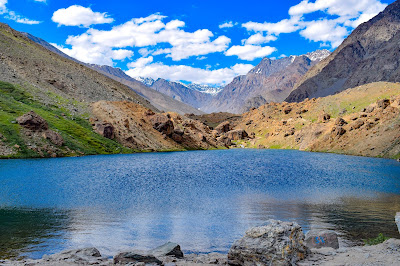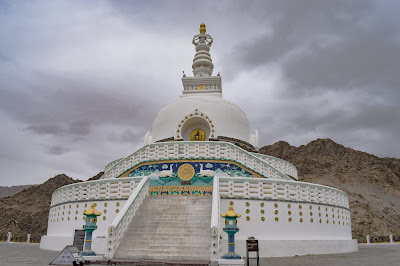Glimps of Ladakh Trip 2018
Ladakh, the land of high passes never ceases to mesmerise you with its breathtaking landscapes and beauteous vistas. The topography in Ladakh dramatically changes every few kilometres and the same place can never look the same when you return. From green valleys to rocky mountains, snow-clad peaks to mighty glaciers, geothermal hot springs to gurgling rivers, turquoise blue lakes to the rainbow mountains- Ladakh has every element to intrigue your curiosity. Ladakh is definitely a destination that seems to be one of God’s favourite creations.

It is part of the state of Jammu and Kashmir. It is located between the Kunlun mountain range in the north and the main Himalayas to the south. Ladakh is well-known for its remote mountain scenery. It is inhabited by a mix of Indo-Aryan and Tibetan people. Ladakh is commonly known as the adventure capital of the country, is the destination that has the top three highest mountain passes in the world. This destination has strong links with Buddhism and Tibetan culture. From architecture to cuisine, this city has an Eastern outlook. This is a very famous tourist destination for those who love isolated adventure spot for many outdoor activities that pump adrenaline into the brain.
Ladakh casts a magic spell on those who visit it. The stark beauty hits you with force and its astounding landscape are at times too much to soak in. At places such as Ladakh, even the camera seems not equipped enough to capture everything. Well i tried to capture everything that is possible, and sharing some of my clicks from Ladakh Trip.
 |
| natural rock formations, pang |
Rock Formation near Kangla Jal on Manali–Leh Highway, Pang The mountain ranges in this region were formed over a period of 45 million years by the folding of the Indian Plate into the stationary landmass of Asia. While the Himalayas were formed from the base material of the Indian plate, the Zanskar Range consists of layers of sediment from the ocean floor, and the Ladakh Range of granite was born of the immense heat generated by the friction between the two plates. Rock carvings found in many parts of Ladakh indicate that the area has been inhabited from Neolithic times. This fomations make Ladakh more picturesque and beautiful.
 |
| Leh Palace |
Leh Palace is a former royal palace overlooking the Ladakhi Himalayan town of Leh. Modelled on the Potala Palace in Lhasa, Tibet, the palace was built by King Sengge Namgyal in the 16th century. It is nine storeys high; the upper floors accommodated the royal family, while the lower floors held stables and store rooms.The roof provides panoramic views of Leh and the surrounding areas, as the mountain of Stok Kangri in the Zangskar mountain range is visible across the Indus valley to the south, with the Ladakh mountain range rising behind the palace is visible in the north.
 |
| landscapes, ladakh |
Ladakh, the land of high passes never ceases to mesmerize you with its breathtaking landscapes.
 |
| pangong lake |
Pangong Tso lake, a secluded water body tucked in the Himalayas, wears the deepest shade of azure and flaunts a beautiful scenery. At a remarkable 14,270 feet, and 154 km to the southeast of Leh, Pangong lake is one of the most picturesque creations of nature. The 134 km long waterbody starts from eastern Ladakh and stretches up to Tibet. The beauty is adorned with fluffy clouds and sharp mirror images of the overlooking mountains reflecting in the brackish water. This is one of the highest endorheic brackish lakes and is also the most sought after attractions in Trans-Himalayan region.
 |
| view of nubra valley from maitreya buddha |
Nubra is a tri-armed valley located to the north east of Ladakh valley. Diskit the capital of Nubra is about 150 km north from Leh town. The Shyok River meets the Nubra to form a large valley that separates the Ladakh and Karakoram Ranges. The Shyok river is a tributary of the Indus river. The average altitude of the valley is about 10,000 ft. i.e. 3048 metres above the sea level. Nubra is a high altitude cold desert with rare precipitation and scant vegetation except along river beds.
 |
| double humped bactrian camel, hunder, ladakh |
Bactrian camel the major attraction of nubra valley found in Hunder.
 |
| prayer flag, ladakh |
A prayer flag is a colourful rectangular cloth, often found strung along mountain ridges and peaks high in the Himalayas. Prayer flags are used to promote peace, compassion, strength, and wisdom. Prayer flags come in sets of five colours. The five colours are arranged from left to right in a specific order: blue, white, red, green, and yellow.According to traditional belief, because the symbols and mantras on prayer flags are sacred, they should be treated with respect. They should not be placed on the ground or used on clothing. Old prayer flags should be burned.
 |
| confluence of indus and zanskar |
One is a shining turquise blue river, other is kind of muddy. Both of them originate in the high Himalayas. Yes they are Indus and Zanskar. While Indus originates in the northern slopes of the Kailash range in Tibet near Lake Manasarovar, the Zanskar river originates in the Zanskar ranges. Both these Himalayan rivers join at a scenic setting near the town of Nimmu in Ladakh.
 |
| buddha statue at hemis monastery |
Main buddha inside Hemis Monastery, Leh Ladakh.
 |
| Deepak Tal Lake, Patseo |
Dipak Tal is a Small lake near Patseo at a height of approximately 12300 feet some 50 km from Keylong on the Manali-Leh highway in Himachal Pradesh. Its crystal clear blue water and picturesque mountains attracts you to take a break before you start climbing Baralacha La.
 |
| Shanti Stupa, Leh |
Shanti Stupa is a Buddhist white-domed stupa on a hilltop in Chanspa, Leh district, Ladakh, in the north Indian state of Jammu and Kashmir.
 |
| Suraj Tal Lake, Baralacha La Pass |
Suraj Tal or Suraj Tal Lake also called Surya taal, is a sacred body of water, literally means the Lake of the Sun God, and lies just below the Bara-lacha-la pass in the Lahaul and Spiti valley of Himachal Pradesh state in India and is the third highest lake in India, and the 21st-highest in the world.
 |
| Ladakhi women at Hemis Monastery |
 |
| Pahalgam,Kashmir |





























Wow superb blog.. Amazing . Keep it up..
ReplyDeleteThanks a lot dear
ReplyDelete